Using filler notes and chords in the Am pentatonic scale.
In this lesson we begin to look inside the Am pentatonic scale. Years ago I learned the possibilities are endless, and a full understanding of this scale and it's origins are vital. The minor pentatonic scale is derived from the major scale. However, it is formed from the natural minor of that particular major scale. For Example: The Am pentatonic scale is formed from the A Aeolian mode. A, B, C, D, E, F, G, A . 1, 2, b3, 4, 5, b6, and b7. The chords that sound good for this scale are Am type chords or A5 chords to name a few.
The pentatonic minor scale has 5 notes. Penta means 5 and tonic means tone.
The notes that make up the Am pentatonic scale are as follows: A C D E and G
1, b3, 4, 5 and b7.
The most popular scales used in rock have to be the pentatonic minor, the blues scale, the Aeolian mode, the Dorian mode and the Mixolydian mode with a little alteration.
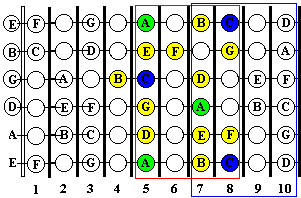 |
|
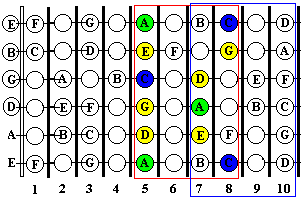 |
|
What I would like to do now, is show you how you can play little filler notes by using parts of the chords formed in the scale. Jimi Hendrix uses this technique in almost every song he recorded. The notes illustrated in red below will be used for this example. Notice the tablature below. The first notes we play are the C and G notes.
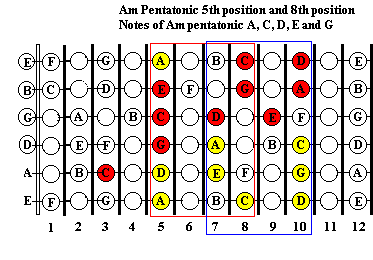 |

|
You may be saying, hey I know these chords? Yes, you may know these chords and you might even use them everyday in your playing. But, do you know where they come from? I would have to say the majority of all questions I received in the years I've be teaching or playing would have to be, where do I play lead, or what chords do I use? I don't want to over whelm you on chord theory here in this chapter, but we need to look at some very interesting things going on here.
Look at the chords below. Look at each chord very closely. Look at the Am7 chord. You should notice that the notes of this chord are, A C E and G. You should also know that the Am7 chord below is a Root 6 bar chord. This means that the chord is determined by the note on the 6th or Low E string. The Dm7 and Em7 are Root 5 bar chords. This means that these chords are determined by the note on the A string. These are movable bar chords which mean you can move each of these chords all over the fret board.
Look at the Dm7 and see that it has the same fingering as the Em7. The only difference is the Dm7 is played at the 5th fret and the Em7 is played at the 7th fret. This is because the D note is at the 5th fret A string for the Dm7 and the E note is at the 7th fret A string for the Em7.
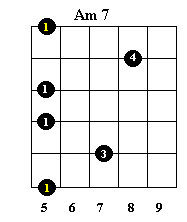 |
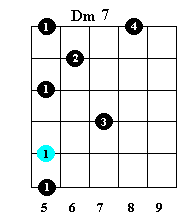 |
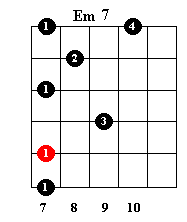 |
| Am 7 is made up of
the 1, b3, 5 and b7 A, C, E and G |
Dm7 is made up of the D, F, A and C |
Em7 is made up of the E, G, B and D |
| A, B, C, D, E,
F, G, 1, 2, b3, 4, 5, b6, b7 |
Each of the chords illustrated above, can be found in the key of C major. Each chord is formed out of the minor scale using the formula above.
 |
 |
| Look at the image above to the right and notice that it is right out of the key of C major. Notice all of the notes of the Am7 chord and begin to visualize playing these notes in your lead guitar work. Lay these chords down on cassette and play these notes as arpeggios. Pick each note one note at a time. Strum the Am7 chord and rock out. Begin to see how each chord if formed for each scale. |
Assignments:
| Use the blank illustrations to fill in the notes of the Am, Am7, Dm, Dm7, Em and Em7 chords. | |
| Use the blank tablature sheets to fill in the chords in arpeggio form. Play each chord above as arpeggios. | |
| Practice the A major scale. | |
| Practice the A major pentatonic scale exercises. | |
| Practice the A major progressions. |
If you use the blank forms and fill them in, you will get to know the fret board inside and out. Use all of the illustrations and experiment. Use the blank illustration of the fret board and fill out all of the notes of the C chord up and down the fret board. Use the blank illustration and fill out all the notes of the Dm chord. You will see where each note is positioned. You will begin to improvise over these different positions and open up endless possibilities and new sounds.
Good Luck,
From the Jam Room

